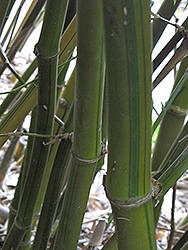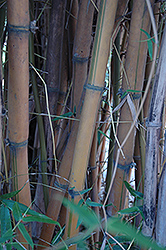It's all about ...
plants

Variegated Buddha's Belly Bamboo
Bambusa tuldoides 'Ventricosa Kimmei'
Height: 40 feet
Spread: 7 feet
Sunlight:
![]()
Hardiness Zone: 8b
Other Names: Painted Buddha Belly, Striped Buddha's Belly
Description:
A large ornamental bamboo, with canes that gracefully arch outwards forming a beautiful vase shaped plant; a tight clumper producing culms that are golden-copper with green striping, and have swollen internodes, shaped like a belly; ideal for screening
Ornamental Features
Variegated Buddha's Belly Bamboo is primarily valued in the landscape for its ornamental globe-shaped form. Its attractive narrow compound leaves emerge yellow in spring, turning dark green in colour the rest of the year. The gold stems are very colorful and add to the overall interest of the plant.
Landscape Attributes
Variegated Buddha's Belly Bamboo is a dense herbaceous evergreen perennial with a more or less rounded form. It brings an extremely fine and delicate texture to the garden composition and should be used to full effect.
This is a relatively low maintenance plant, and is best cleaned up in early spring before it resumes active growth for the season. It has no significant negative characteristics.
Variegated Buddha's Belly Bamboo is recommended for the following landscape applications;
- Mass Planting
- Hedges/Screening
- Windbreaks and Shelterbelts
- Naturalizing And Woodland Gardens
- Container Planting
Planting & Growing
Variegated Buddha's Belly Bamboo will grow to be about 40 feet tall at maturity, with a spread of 7 feet. It has a low canopy with a typical clearance of 3 feet from the ground. It grows at a fast rate, and under ideal conditions can be expected to live for approximately 10 years. As an evegreen perennial, this plant will typically keep its form and foliage year-round.
This plant should only be grown in full sunlight. It does best in average to evenly moist conditions, but will not tolerate standing water. It is not particular as to soil type or pH. It is highly tolerant of urban pollution and will even thrive in inner city environments. Consider applying a thick mulch around the root zone in winter to protect it in exposed locations or colder microclimates. This is a selected variety of a species not originally from North America. It can be propagated by division; however, as a cultivated variety, be aware that it may be subject to certain restrictions or prohibitions on propagation.
Variegated Buddha's Belly Bamboo is a fine choice for the garden, but it is also a good selection for planting in outdoor pots and containers. Because of its height, it is often used as a 'thriller' in the 'spiller-thriller-filler' container combination; plant it near the center of the pot, surrounded by smaller plants and those that spill over the edges. It is even sizeable enough that it can be grown alone in a suitable container. Note that when growing plants in outdoor containers and baskets, they may require more frequent waterings than they would in the yard or garden. Be aware that in our climate, most plants cannot be expected to survive the winter if left in containers outdoors, and this plant is no exception. Contact our experts for more information on how to protect it over the winter months.
This plant is not reliably hardy in our region, and certain restrictions may apply; contact the store for more information.

